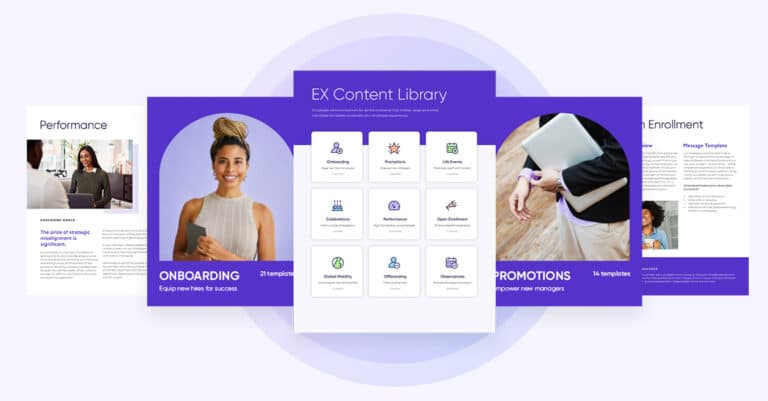For many communicators, evaluating internal communication metrics is a weak spot. Our survey revealed that only 56% of respondents tracked website analytics, 44% monitored email clicks, and 19% didn’t measure internal communications at all. Furthermore, only 22% felt confident that their internal communication strategy effectively improved their content.
This lack of confidence translates into how rarely data and insights were used or shared. While more than two-thirds of internal communicators shared their internal communication metrics with executive teams, a staggering 70% reported that leadership didn’t even ask for these metrics. This data on internal communications often goes overlooked and underutilized.
Employee feedback is being ignored and communication efforts aren’t yielding action. That needs to change.
Using data and analysis to drive success
As you begin measuring key internal communication metrics, think about how you will use these insights to refine your internal communications strategy and meet business objectives.
Components of data driven internal communications
Qualitative and quantitative data
Focus groups, surveys, and interviews offer qualitative insights into employee preferences. However, what employees say doesn’t always align with their actions, which is where quantitative data, such as engagement rates and clicks, becomes essential.
For instance, employees may state a preference for written updates from leadership, but data might show that corporate videos get 60% more engagement. If you look at both datasets, you can conclude that the people who don’t love video are likely to answer that way in a survey.
But that doesn’t mean you should stop doing video!
Combining qualitative and quantitative data gives you the full picture and informs better internal communication strategies.

Cohort analysis
Cohort analysis helps you understand how different segments of your audience behave over time. For example, you could look at active users of your internal communication platform. Cohort 1 could be new users, and Cohort 2 could consist of users active over the last 90 days. By analyzing how these cohorts interact with your internal communications, you can better serve their needs.
Determine the question you want to answer. For example, “How do I improve retention?” Identify a specific action such as how often these two cohort’s employees return to the app over the course of two weeks. Then, you compare each cohort’s behavior within that time frame. You’ll see differences between each group at points in time and know how better to serve all users.
Benchmarking your results
Benchmarking helps you assess performance against a set of internal communication metrics. While internal communications have traditionally lacked specific benchmarks, Firstup is leading the way by providing weekly and monthly benchmarking data for all customers.
First, identify what you want to benchmark. For example, if increasing employee engagement is your goal, benchmark retention rates over time and compare them to similar programs. How do your click-through rates on content and monthly active users compare?

By establishing a benchmark, you can measure future performance, better understand your audience, and prove the value of your internal communications efforts in driving business outcomes.
Setting your internal communications goals
Every organization and team is unique, meaning the internal communications metrics for your strategy should be tailored to your specific situation. Measurement will help narrow your focus to align with your desired outcomes and available resources.
Setting key performance indicators (KPIs) and actionable objectives is crucial to driving improvement.
Steps to establish internal communications goals:
1. Identify your company’s goals
What are your business strategies? Ensure you fully understand company-wide goals so that your internal communication goals align and support these strategies.
2. Establish objectives for your communications
Start by focusing on your current campaigns or initiatives. Ask yourself:
- What internal communications campaign or initiative do I want to run?
- Which channels are most effective for this campaign?
- What are my desired outcomes?
- How many employees do I need to reach?
- What are my success metrics?
For example, if your initiative is to engage frontline workers through a live-streamed town hall, consider past attendance and participation. A measurable goal could be to increase frontline worker attendance by 50%.

3. Review available metrics and how to use them
After defining success, develop your strategy for measuring it. Break down campaign activities to plan your internal communication channels:
- Which channels will you use?
- How will you test their effectiveness?
- How will you measure performance on those channels?
Each communication channel—whether it’s your intranet, internal communications platform, or company email—comes with different metrics for measuring employee engagement.
For example, email performance might focus on open and click-through rates, while a branded communications app may track likes, comments, and other forms of employee engagement.
Analyzing these engagement metrics will help you establish a champion channel strategy.
4. Determine your internal communications metrics
To track progress, define KPIs in relation to broader business objectives. As internal communications professionals, you might set KPIs around increasing employee engagement by 20% annually.

Internal communication metrics, on the other hand, measure the success of specific actions like content performance. The distinction is that KPIs connect to overall business strategies, whereas metrics are tactical and campaign-specific.
Both, however, must be quantifiable and shared to demonstrate the impact of internal communications efforts on company goals.
Demonstrate to your entire organization the impact of your internal communications and how they drive business outcomes by sharing your KPIs and communication metrics.
Set a baseline
Before you can measure internal communications effectiveness, you need to establish baseline metrics. Take stock of your current numbers and tracking methods. These will serve as your reference point for measuring progress.
Responses and feedback
Employee surveys and focus groups offer valuable insights. For the best results, ensure anonymity in surveys to encourage honest feedback. Ask clear, objective questions like, “On a scale of 1 to 10, how effectively does the company communicate internally?”
Tailor surveys by role, location, or department for more precise data. In-person focus groups can also help identify deeper issues.
Track engagement
- It’s not just about distributing messages—it’s about tracking how many employees are engaged with your communication. By leveraging an internal communications platform to track employee engagement, you can identify communication gaps and take corrective action.
- What kind of engagement numbers are tracked? If you asked most managers or human resources professionals, they would say email open rates or intranet logins. However, a more effective way of measuring might be email CTRs or shares. Open rates and intranet logins only show that an employee is aware of the information being distributed. But, measuring CTRs, or company news, that is shared, indicates that your employees are truly engaging with your message and communication strategy.
Turnover
High employee turnover can signal ineffective internal communication. When employees feel informed, respected, and trusted, they are more likely to stay with the company. Monitoring turnover is a simple yet powerful KPI that provides insight into how well your internal communications are performing. This is an easy KPI to track.
Reaching employees
This internal communication metric KPI is often underappreciated. Two of the biggest issues in modern digital workplace communication are the number of dispersed workers and channel adoption rates of the current company intranet systems.
In fact, 43% of employees work remotely at least part-time, yet nearly a third of them never visit the company intranet. If employees aren’t reading your communications, they aren’t being impacted.
Employee advocacy
Another overlooked internal communication KPI is Employee Advocacy, which goes hand-in-hand with employee engagement. Transforming your employees into passionate advocates for your brand can make a huge impact.When internal communication strategies connect employees to the company’s mission, they’re more likely to advocate for your brand, which enhances retention and productivity.
Hyper-personalized comms for every employee
5. Choose the cadence to measure success
Once you’ve identified which metrics you’re tracking, it’s essential to record and review them over time. Use your Firstup dashboard or a spreadsheet to evaluate your internal communications strategy.
For example, if you’re measuring video performance on your branded internal communications platform, focus on key engagement metrics like impressions, views, and interactions.
Utilize your workforce communications platform or spreadsheet to track these metrics over a defined period. You might choose to review data weekly to document video performance. Benchmark this data against other video content to gauge success and make comparisons.

After collecting enough data, analyze the results and generate insights to help identify opportunities for improvement. For instance, if you find that video content on your internal communications app is most popular when it’s freshly posted, you may decide to measure its effectiveness during this initial window as a success indicator.
This ongoing process will lead to more discoveries, such as ideal content length, optimal posting times, and the types of content that engage your audience best. You can then use these insights to test and refine your communication strategies.
Tracking internal communications metrics with Analyze
We provide the data you need to thrive amidst significant changes in your workforce and technology landscape. The Analyze dashboard is designed to help you track internal communications metrics, revealing what resonates with your workforce—by location, function, tenure, line manager, and more. This tool leverages intelligence to perform analysis, optimizing the delivery of messages to drive key business outcomes.
Executives rely on accurate information to make informed decisions. With Analyze, you’ll have access to detailed communications analytics and insights that show how communications impact business strategy.
“We look forward to tracking strategic initiatives and how they are resonating with our different employee groups around the world. Getting the right message to the right employees and partners — and tracking the results — is a key driver for our business.“
Norman Rice, COO, Extreme Networks
To support this, we developed How to Measure Internal Communications, a comprehensive guide that explains why measuring internal communications metrics is crucial, outlines what and how to measure, and suggests actions to improve and measure employee engagement.
Our goal is to empower internal communicators to embrace analytics, positioning them as leading content creators, communicators, and internal marketers. By leveraging insights from internal communications data, you’ll reach every employee with the right message at the right time, while also collecting and acting on employee feedback.
How can internal communications improve the employee experience?
Communication metrics and analytics function as a continuous feedback loop, providing valuable insights over time. By benchmarking your activities as a baseline and then measuring success on a monthly, quarterly, or yearly basis, you can make real-time adjustments to your internal comms strategy based on employee and leadership responses.
How to build a better employee email
Learn how to start engaging with employees, instead of just filling up their inboxes
For many internal communicators, measuring internal communications can seem daunting. However, your employees, leaders, and the broader organization need you to make this transformation.
Most departments within your company already operate based on data, and this is your opportunity to elevate yourselves as internal communication professionals and demonstrate your value to the executive level.
By learning to measure internal communication, you can gain insights in two key ways:
- Understanding what motivates and boosts employee morale will allow you to track improvements in the overall employee experience.
- Measuring organizational alignment ensures you know whether employees are responding to leadership mandates and grasping their role within the company.
Using data to address communications challenges
As you strive to enhance the employee experience and improve organizational alignment, key metrics can help you understand what employees need to succeed.
By analyzing this data, you can personalize your internal communications to meet the specific needs of your workforce, ensuring your messaging is relevant and impactful.
Consider the following:
- What content and information do employees care about most?
- What key information do they need to know?
- What are their preferred channels?
- Does the timing of your communication (day or time) impact engagement?
Employees want and expect targeted, relevant content from internal communicators. By measuring and analyzing the effectiveness of your communications, you can refine your strategy and drive greater alignment with broader business goals.
Final steps to launch your internal communications strategy
Here are five steps to kickstart a successful internal communications strategy:
- Identify key challenges
- Highlight problems that need to be solved, such as understanding employee needs or engagement gaps.
- Evaluate comms channels
- Assess the channels you currently use. Determine what internal comms metrics you need to track and assign responsibility to specific team members.
- Establish a continuous analysis process
- Develop a clear methodology for tracking and analyzing communication KPIs over time to ensure consistent evaluation.
- Incorporate feedback and define progress
- Align your findings with your team, collect employee feedback, and outline specific actions to measure the effectiveness of internal communications.
- Continuously review and improve
- Regularly review and refine your processes to maintain a steady flow of insights, ensuring your strategy evolves and remains relevant to business goals.
By following these steps, your internal communications team will be better equipped to measure success, increase employee engagement, and align with broader business outcomes.
How to Measure Internal Communications
Learn what a successful communication program looks like and start tracking your communications metrics











